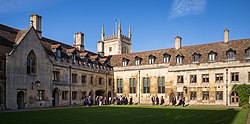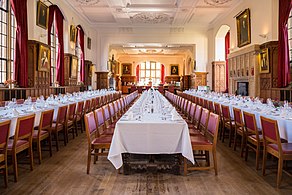Difference between revisions of "Pembroke College, Cambridge"
(Created page with "{{Infobox college |name=Pembroke College |county=Cambridgeshire |university=Cambridge |os grid ref=TL44985809 |latitude=52.202 |longitude=0.120 |city=Cambridge |picture=Gradua...") |
(No difference)
|
Latest revision as of 20:01, 3 April 2024
| Pembroke College
| |||||||||||
 Old Court, Pembroke College | |||||||||||
|---|---|---|---|---|---|---|---|---|---|---|---|
| Master: | The Lord Smith of Finsbury | ||||||||||
| Website: | pem.cam.ac.uk | ||||||||||
| |||||||||||
| Location | |||||||||||
| Grid reference: | TL44985809 | ||||||||||
| Location: | 52°12’7"N, 0°7’12"E | ||||||||||
Pembroke College (officially "The Master, Fellows and Scholars of the College or Hall of Valence-Mary") is a constituent college of the University of Cambridge,[1], in Cambridgeshire.
The college is the third-oldest college of the university and has over 700 students and fellows. It is one of the university's larger colleges, with buildings from almost every century since its founding, as well as extensive gardens. Its members are termed "Valencians".
Pembroke has a level of academic performance among the highest of all the Cambridge colleges; in 2013, 2014, 2016, and 2018 Pembroke was placed second in the Tompkins Table. Pembroke contains the first chapel designed by Sir Christopher Wren and is one of only six Cambridge colleges to have educated a British prime minister, in Pembroke's case William Pitt the Younger. The college library, with a Victorian neo-gothic clock tower, has an original copy of the first encyclopaedia to contain printed diagrams.
Contents
History
Marie de St Pol, Countess of Pembroke (1303–1377), a member of the de Châtillon family of France, founded Pembroke College, Cambridge. On Christmas Eve 1347, Edward III granted Marie de St Pol, widow of the Earl of Pembroke, the licence for the foundation of a new educational establishment in the young university at Cambridge. The Hall of Valence Mary ("Custos & Scolares Aule Valence Marie in Cantebrigg'"), as it was originally known, was thus founded to house a body of students and fellows.[2] The statutes were notable in that they both gave preference to students born in France who had already studied elsewhere in England, and that they required students to report fellow students if they indulged in excessive drinking or visited disreputable houses.
The college was later renamed Pembroke Hall, and finally became Pembroke College in 1856.
Marie was closely involved with College affairs in the 30 years until her death and burial at Denny Abbey, to the north of Cambridge, in 1377. She seems to have been something of a disciplinarian: the original Foundation documents had strict penalties for drunkenness and lechery, required that all students' debts were settled within two weeks of the end of term, and gave strict limits on numbers at graduation parties.
In 2015, the college received a bequest of £34 million from the estate of American inventor and Pembroke alumnus Ray Dolby, thought to be the largest single donation to a college in the history of Cambridge University.
Buildings
Old Court
The first buildings of the College comprised a single court (now called Old Court) containing all the component parts of a college – chapel, hall, kitchen and buttery, master's lodgings, students' rooms – and the statutes provided for a manciple, a cook, a barber and a laundress. Both the founding of the college and the building of the city's first college Chapel (1355) required the grant of a papal bull.
The original court was the university's smallest at only 95 feet by 55 feet, but was enlarged to its current size in the nineteenth century by demolishing the south range.
The college's gatehouse is the oldest in Cambridge.
Chapel
The original Chapel now forms the Old Library and has a striking seventeenth-century plaster ceiling, designed by Henry Doogood, showing birds flying overhead. Around the Civil War, one of Pembroke's fellows and Chaplain to the future Charles I, Matthew Wren, was imprisoned by Oliver Cromwell. On his release after eighteen years, he fulfilled a promise by hiring his nephew Christopher Wren to build a great Chapel in his former college. The resulting Chapel was consecrated on St Matthew's Day, 1665, and the eastern end was extended by George Gilbert Scott in 1880, when it was consecrated on the Feast of the Annunciation.
Expansion
An increase in membership over the last 150 years saw a corresponding increase in building activity. The Hall was rebuilt in 1875–1876 to designs by Alfred Waterhouse after he had declared the mediæval Hall unsafe. As well as the Hall, Waterhouse designed a new range of rooms, Red Buildings (1871–1872), in French Renaissance style, designed a new Master's Lodge on the site of Paschal Yard (1873, later to become N staircase), pulled down the old Lodge and the south range of Old Court to open a vista to the chapel, and finally designed a new Library (1877–1878) in the continental Gothic style. The construction of the new library was undertaken by Rattee and Kett.[3]
Waterhouse was dismissed as architect in 1878 and succeeded by George Gilbert Scott, who, after extending the chapel, provided additional accommodation with the construction of New Court in 1881, with letters on a series of shields along the string course above the first floor spelling out the text from Psalm 127:1, Nisi Dominus aedificat domum… ("Except the Lord build the house, their labour is but vain that build it").
Building work continued into the 20th century with W. D. Caröe as architect. He added Pitt Building (M staircase) between Ivy Court and Waterhouse's Lodge, and extended New Court with the construction of O staircase on the other side of the Lodge. He linked his two buildings with an arched stone screen, Caröe Bridge, along Pembroke Street in a late Baroque style, the principal function of which was to act as a bridge by which undergraduates might cross the Master's forecourt at first-floor level from Pitt Building to New Court without leaving the college or trespassing in what was then the Fellows' Garden.
In 1926, as the Fellows had become increasingly disenchanted with Waterhouse's Hall, Maurice Webb was brought in to remove the open roof, put in a flat ceiling and add two storeys of sets above. The wall between the Hall and the Fellows' Parlour was taken down, and the latter made into a High Table dais. A new Senior Parlour was then created on the ground floor of Hitcham Building. The remodelling work was completed in 1949 when Murray Easton replaced the Gothic tracery of the windows with a simpler design in the style of the mediæval Hall.
In 1933 Maurice Webb built a new Master's Lodge in the south-east corner of the College gardens, on land acquired from Peterhouse in 1861. Following the war, further accommodation was created with the construction in 1957 of Orchard Building, so called because it stands on part of the Foundress's orchard. Finally, in a move to accommodate the majority of junior members on the College site rather than in hostels in the town, in the 1990s Eric Parry designed a new range of buildings on the site of the Master's Lodge, with a new Lodge at the west end. "Foundress Court" was opened in 1997 in celebration of the college's 650th Anniversary. In 2001 the Library was extended to the east and modified internally.
In 2017, Pembroke College launched a new campaign of extension called the "Time and The Place"[4] (or the Mill Lane project), on the other side of Trumpington Street. The project is to enlarge the size of the college by a third, with new social spaces, rooms and offices.[5]
Gardens
Pembroke's enclosed grounds include garden areas. Highlights include "The Orchard" (a patch of semi-wild ground in the centre of the college), an impressive row of plane trees and a bowling green, re-turfed in 1996, which is reputed to be among the oldest in continual use in Europe.
Pictures
| ("Wikimedia Commons" has material about Pembroke College, Cambridge) |
Outside links
References
- ↑ Walker, Timea (2022-02-02). "Pembroke College" (in en). https://www.undergraduate.study.cam.ac.uk/colleges/pembroke-college.
- ↑ "Plea Rolls of the Court of Common Pleas; National Archives; CP 40/555; dated 1399, first year of King Henry IV; sixth entry". http://aalt.law.uh.edu/H4/CP40no555/aCP40no555fronts/IMG_0163.htm.
- ↑ "Rattee and Kett". Capturing Cambridge. http://www.capturingcambridge.org/wp-content/uploads/2017/01/0035d.pdf.
- ↑ Pembroke College, Cambridge (2019). "The Time and The Place: A campaign for Pembroke". https://www.thetimeandtheplace.org.uk.
- ↑ "Mill Lane development". Cambridge Independent. 2 February 2019. https://www.cambridgeindependent.co.uk/news/public-spaces-and-art-gallery-included-in-plans-for-major-redesign-of-pembroke-college-9060908.
| Colleges of the University of Cambridge | |
|---|---|
|
Christ’s • Churchill • Clare • Clare Hall • Corpus Christi • Darwin • Downing • Emmanuel • Fitzwilliam • Girton • Gonville and Caius • Homerton • Hughes Hall • Jesus • King’s • Lucy Cavendish • Magdalene • Murray Edwards • Newnham • Pembroke • Peterhouse • Queens’ • Robinson • St Catharine’s • St Edmund’s • St John’s • Selwyn • Sidney Sussex • Trinity • Trinity Hall • Wolfson |
|








